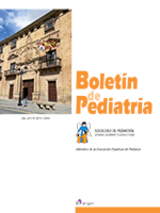Encuesta de conocimiento de precios de la actividad sanitaria: ¿sabemos cuánto cuestan nuestras decisiones?
A. López Martínez , L. Mantecón Fernández , S. Rekarte García , D. García Rodríguez , J. Ron Gudín , G. Solís Sánchez
Bol. Pediatr. 2014; 54 (227): 36 - 42
Objetivo. Medir el conocimiento del precio de nuestras decisiones en la práctica clínica habitual en un Área de Gestión Clínica Pediátrica de un hospital público. Material y métodos. Encuesta individual escrita y anónima al personal sanitario [pediatras (FEAs), médicos internos residentes (MIRs) y personal de enfermería (DUEs)] del Área de Gestión Clínica de Pediatría de un hospital universitario. Se preguntó por el precio de ítems de actividad sanitaria: consulta/hospitalización; pruebas de laboratorio; pruebas de imagen; pruebas microbiológicas; material y técnicas; y tratamientos. Las respuestas se analizaron frente a valores de referencia en nuestro hospital. Resultados. Se analizaron 97 cuestionarios. El precio global fue sobrevalorado un 5% del precio real, aunque el 56% de encuestados infravaloró dicho precio global. Agrupados en seis grupos de ítems, fármacos y consultas/hospitalizaciones se infravaloraron, mientras que el resto de grupos se sobrevaloraron. La suma del precio de todos los fármacos se infravaloró en el 10% y la de todas las modalidades de consulta/hospitalización en el 25%. Los otros cuatro grupos se sobrevaloraron: analíticas de sangre en el 589%, material de técnicas en el 128%, pruebas microbiológicas en el 81% y pruebas de imagen en el 57%. En el análisis global de encuesta, las comparaciones por grupos no mostraron diferencias estadísticas signifi cativas para total de encuesta por sexos ni por grupos de edad, pero sí para tipo de profesional (ANOVA p=0,03). MIRes y FEAs infravaloraban la encuesta, mientras que DUEs la sobreestimaban. Conclusiones. Existe un gran desconocimiento en el valor económico de costes sanitarios y gran variabilidad en su apreciación, entre el personal que trabaja en el sistema público de salud.
Survey of knowledge about health care activity prices: do we know how much our decisions cost?
Objective. To measure degree of knowledge about how much daily clinical practice cost in a pediatric clinical hospital.
Material and methods. Individual, anonymous and written surveys were carried out by pediatric physicians (FEAs), pediatric resident physicians (MIRes) and nurses (DUEs). All of them were workers in a pediatric department of a university hospital. Survey asked for price of different items used in daily practice: consultation/hospitalization, diagnostic laboratory test, imaging test, microbiological test, techniques, materials used for techniques and treatments. Responses were analyzed having in count reference values established in our hospital.
Results. We analyzed 97 surveys. Global price survey was overvalued by 5%, although the 56% of the respondents underestimated global price. Grouped into six groups of items, drugs and consultations/hospitalizations were underestimated, while the rest of the items were overestimated. Drugs price were underestimated by 10%, and all different forms of consultation/hospitalization by 25%. Other four groups were overestimated: blood test in 589%, material used for the techniques in 128%, microbiological test in 81% and imaging tests in 57%. In overall analysis of survey, comparisons of groups showed no statistically significant differences for total survey by gender and by group of age. However, statistically differences were found in type of professional we analyzed (ANOVA p=0,03). FEAs and MIRes underestimated the survey while DUEs overestimated it.
Conclusions. There is great ignorance on economic value of healthcare costs. There is, as well, great variability in their appreciation among the staff who works in the public health system.
Artículo completo (PDF) (269 kb.)
- Otros
